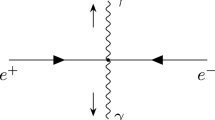Abstract
Some future space missions measure distances of laser links and angles with unprecedented precision, allowing us to test theories of gravity up to the two-post-Newtonian (2PN) order. Besides, investigation of an intermediate-range force has been of considerable interests in gravitational experiments. Inspired by these ideas, within the framework of the scalar-tensor theory with an intermediate-range force, its 2PN approximation is obtained with Chandrasekhar’s approach. It includes the 2PN metric and equations of motion for general matter without specific equation of state. The conserved quantities to the 2PN order are isolated with the aid of the energy-momentum complex. We also discuss the prospect of testing and distinguishing the intermediate-range force with the orbital motions of celestial bodies and spacecrafts.
Similar content being viewed by others
References
Ciufolini I, Pavlis E C. A confirmation of the general relativistic prediction of the Lense-Thirring effect. Nature, 2004, 431: 958–960
Murphy T W, Adelberger E G, Battat J B R, et al. The Apache point observatory lunar laser-ranging operation: Instrument description and first detections. Publ Astron Soc Pac, 2008, 120: 20–37
Fomalont E, Kopeikin S, Lanyi G, et al. Progress in measurements of the gravitational bending of radio waves using the VLBA. Astrophys J, 2009, 699: 1395–1402
Turyshev S G, Shao M, Nordtvedt K Jr. New concept for testing general relativity: The Laser Astrometric Test Of Relativity (LATOR) mission. Astron Nachr, 2004, 325: 267–277
Turyshev S G, Shao M, Nordtvedt K Jr. The laser astrometric test of relativity mission. Class Quant Grav, 2004, 21: 2773–2799
Turyshev S G, Farr W, Folkner W M, et al. Advancing tests of relativistic gravity via laser ranging to Phobos. Exp Astron, 2010, 28: 209–249
Turyshev S G, Shao M, Girerd A, et al. A search for new physics with the Beacon Mission. Int J Mod Phys D, 2009, 18: 1025–1038
Fujii Y, Maeda K. The Scalar-Tensor Theory of Gravitation. Cambridge: Cambridge Univesity Press, 2005. 2–37
Deng X M, Xie Y, Huang T Y. A modified scalar-tensor-vector gravity theory and the constraint on its parameters. Phys Rev D, 2009, 79: 044014
Deng X. Constraints on a scalar-tensor theory with an intermediate-range force by binary pulsars. Sci China-Phys Mech Astron, 2011, 54: 2071–2077
Xie Y, Ni W T, Dong P, et al. Second post-Newtonian approximation of scalar-tensor theory of gravity. Adv Space Res, 2009, 43: 171–180
Blanchet L, Damour T. Post-Newtonian generation of gravitational waves. Ann Inst Henri Poincaré, 1989, 50: 377–408
Damour T, Esposito-Farèse G. Tensor-multi-scalar theories of gravitation. Classical Quantum Gravity, 1992, 9: 2093–2176
Damour T, Esposito-Farèse G. Tensor-scalar gravity and binary-pulsar experiments. Phys Rev D, 1996, 53: 5541–5578
Misner C W, Thorne K S, Wheeler J A. Gravitation. Freeman: San Francisco Press, 1973. 8–10
Chandrasekhar S. The post-Newtonian equations of hydrodynamics in general relativity. Astrophys J, 1965, 142: 1488–1512
Kopeikin S, Vlasov I. Parametrized post-Newtonian theory of reference frames, multipolar expansions and equations of motion in the N-body problem. Phys Rep, 2004, 400: 209–318
Nordtvedt K J, Will C M. Conservation laws and preferred frames in relativistive gravity. II. Experimental evidence to rule out preferred-frame theories of gravity. Astrophys J, 1972, 177: 775–792
Will C M, Nordtvedt K J. Conservation laws and preferred frames in relativistive gravity. I. Preferred-frame theories and an extended PPN formalism. Astrophys J, 1972, 177: 757–774
Nutku Y. The energy-momentum complex in the Brans-Dicke theory. Astrophys J, 1969, 158: 991–996
Chandrasekhar S. The second post-Newtonian equations of hydrodynamics in general relativity. Astrophys J, 1969, 158: 55–79
Deng X, Xie Y. Yukawa effects on the clock onboard a drag-free satellite. Mon Not R Astron Soc, 2013, 431: 3236–3239
Xie Y, Deng X. On the (im)possibility of testing new physics in exoplanets using transit timing variations: Deviation from inverse-square law of gravity. Mon Not R Astron Soc, 2014, 438: 1832–1838
Fischbach E, Sudarsky D, Szafer A, et al. Reanalysis of the Eötvös experiment. Phys Rev Lett, 1986, 56: 3–6
Author information
Authors and Affiliations
Corresponding author
Rights and permissions
About this article
Cite this article
Deng, X. Two-post-Newtonian approximation of the scalar-tensor theory with an intermediate-range force for general matter. Sci. China Phys. Mech. Astron. 58, 1–8 (2015). https://doi.org/10.1007/s11433-014-5589-8
Received:
Accepted:
Published:
Issue Date:
DOI: https://doi.org/10.1007/s11433-014-5589-8




